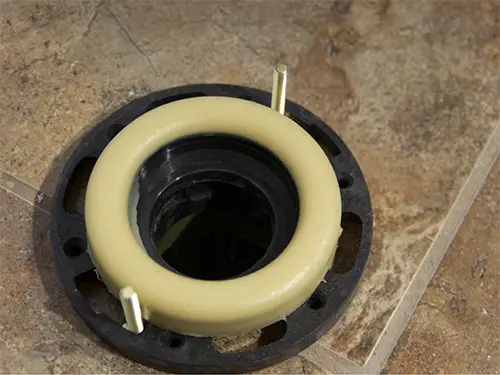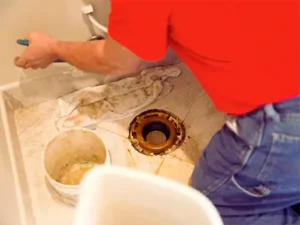 The toilet wax ring is a small but essential part of your plumbing system. It forms a tight seal between the toilet base and the sewer pipe, preventing leaks and stopping sewer gases from escaping into your bathroom.
The toilet wax ring is a small but essential part of your plumbing system. It forms a tight seal between the toilet base and the sewer pipe, preventing leaks and stopping sewer gases from escaping into your bathroom.
While it may not receive much attention, a failing wax ring can lead to water damage, unpleasant odors, and even health risks. This article explores the signs of a bad wax ring, common causes of leaks, and how to address these problems.
Key Takeaways
- Toilet wax rings can fail over time, causing leaks or odors.
- Common signs include water pooling, an unstable toilet, or sewer smells.
- Some leaks may not be related to the wax ring and could involve bolts, supply lines, or the toilet flange.
- Prompt replacement prevents further plumbing or structural damage.
- Professional plumbers ensure a proper fix, saving you time and stress.
Common Signs Your Toilet Wax Ring Is Failing
A failing wax ring often gives clear warning signs. Recognizing these issues early can prevent costly repairs.
Water Pooling Around the Toilet Base
If you notice water around the bottom of the toilet, it might indicate wax ring failure. Start by cleaning up the water and monitoring the area. Ensure the water isn’t from splashes or spills.
If pooling reoccurs, the wax seal is likely compromised, and a replacement is necessary. Contact a plumber for further inspection to confirm the problem.
Your Toilet Is Unstable
A toilet should sit firmly on the floor. If your toilet moves or rocks, it can break the wax seal, leading to leaks. Once the seal is broken, it cannot reseal itself.
The solution involves pulling the toilet, replacing the wax ring, and resecuring it to the floor.
Toilet Smells Like Sewage
One of the most unpleasant signs of a bad wax ring is a persistent sewer odor. Sewer gases escaping through a damaged wax seal can create a hazardous environment.
If you smell sewage near your toilet, act quickly. Sewer gases are harmful and could even ignite near an open flame. Call a plumber immediately to assess the issue.
Ceiling or Floor Damage
Leaking water from a failed wax ring may not always be visible around the toilet base. Instead, you might see mold or water stains on the ceiling below the bathroom.
In severe cases, water can weaken the floor around the toilet, creating soft spots or structural risks. Address these issues quickly to avoid more extensive damage.
Mold Around Your Toilet
Dampness from a leaking wax ring fosters mold growth. Look for black mold spots around the base of the toilet.
Mold not only damages surfaces but also poses health risks. Replacing the wax ring and cleaning the area thoroughly can prevent further issues.
Non-Wax Related Toilet Leaks
 Not all toilet leaks stem from wax ring problems. Before replacing the wax ring, consider these potential culprits:
Not all toilet leaks stem from wax ring problems. Before replacing the wax ring, consider these potential culprits:
Bolts
Loose or corroded bolts can allow water to escape at the base of the toilet. Tightening or replacing these bolts often resolves the issue without needing to replace the wax ring.
Supply Line
The water supply line running from the wall to your toilet can develop leaks due to wear or corrosion. Inspect this line for damage and replace it if necessary.
Failing Flange
The flange, which connects the toilet to the sewer pipe, can crack or become misaligned over time. A damaged flange may need repair or replacement to ensure a proper seal.
Sewer Line Problems
In rare cases, underlying sewer line issues can mimic wax ring failure. If other fixtures in your home also drain slowly or smell like sewage, a sewer line problem may be the cause.
Need Toilet Wax Ring Replacement?
 Delaying repairs for a failing wax ring can lead to severe plumbing issues, including water damage and costly structural repairs. While replacing a wax ring is a manageable DIY project for experienced homeowners, it’s often best to leave it to the professionals.
Delaying repairs for a failing wax ring can lead to severe plumbing issues, including water damage and costly structural repairs. While replacing a wax ring is a manageable DIY project for experienced homeowners, it’s often best to leave it to the professionals.
Service Minds Benjamin Franklin Plumbing offers reliable and affordable solutions. Our punctual plumbers ensure the job is done right the first time, preventing future problems and giving you peace of mind.
FAQs
If you’re still unsure about wax ring problems, these FAQs can help clarify common concerns.
What causes a toilet wax ring to go bad?
Wax rings fail due to age, improper installation, or movement of the toilet. Over time, the wax can lose its shape and effectiveness.
Are toilet wax rings universal?
No, wax rings are not universal. They come in different sizes and thicknesses to fit various toilet models and flange heights. When replacing a wax ring, ensure you choose one compatible with your toilet and flange to create a proper seal.
Can I use a non-wax ring as a replacement?
Yes, non-wax alternatives are available and can be easier to install. These options work well in most cases and are less messy than traditional wax rings.
How long does a toilet wax ring last?
A properly installed wax ring can last 20–30 years. However, factors like frequent toilet movement or improper installation can shorten its lifespan.
Do I need to replace the flange when replacing the wax ring?
Not always. Inspect the flange for cracks or damage. If it’s in good condition, you can reuse it.
Can I replace a wax ring myself?
If you have experience with plumbing repairs, replacing a wax ring is a straightforward process. If you’re unsure, it’s best to call a plumber.
What happens if I ignore a bad wax ring?
Ignoring a failing wax ring can lead to water damage, mold growth, and sewer gas exposure. Over time, these issues can cause expensive repairs and health hazards.
Final Thoughts
A failing toilet wax ring can lead to significant plumbing and structural problems. Early identification of issues such as leaks, odors, or unstable toilets is crucial. Ignoring these signs can result in costly water damage and health risks.
Acting promptly by replacing the wax ring or consulting a professional ensures your bathroom remains safe and functional. For reliable toilet repairs, trust Service Minds Benjamin Franklin Plumbing. Our punctual plumbers are here to help you prevent leaks and restore your peace of mind.